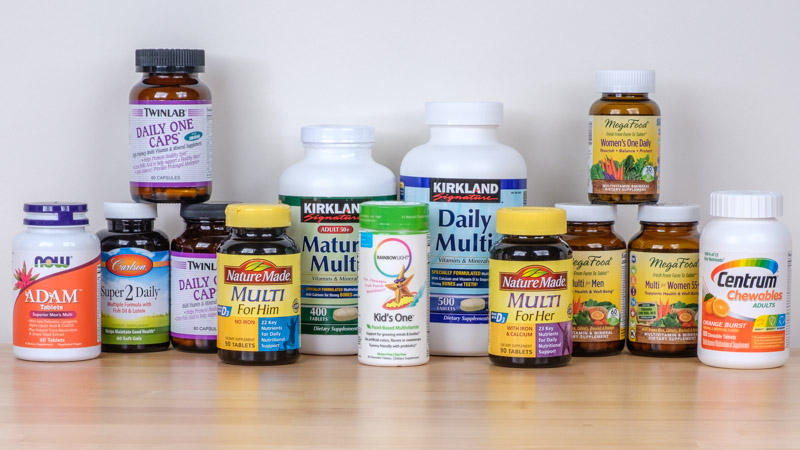Would it surprise you to know that multi-vitamins are the most common dietary supplement used in the U.S., consumed by nearly a third of all adults? When the average person adds a nutritional supplement to their diet, a multi-vitamin is likely to be the first choice, because it feels to them like they’re taking out “insurance” on their health.
Traditionally, a daily multi-vitamin is meant to prevent nutritional deficiency. The specific combination of essential vitamins and minerals in these supplements is deliberately designed to resemble healthy diet patterns, specifically that of regular fruit and vegetable consumption.
It’s not just the average Joe and Jane though that take multi-vitamins. Professional healthcare providers believe in dietary supplements too. In an online survey, 900 physicians and 277 nurses were asked whether they used dietary supplements and whether they recommended them to their patients.
The “Life…supplemented” Healthcare Professionals Impact Study (HCP Impact Study) reported that 51% of physicians and 59% of nurses surveyed used dietary supplements regularly to maintain their overall health and wellness.
When asked whether they recommended dietary supplements to their patients, 79% of the physicians and 82% of nurses surveyed said they did.
Clearly, there’s something to be said for the multi-vitamin approach!
However, as an educated consumer, what should you know about commercially available multi-vitamins on the market today and their potential effects on your health?
Let’s take a look at 5 important issues you should consider when selecting a suitable multi-vitamin for your health needs.
Fact #1: Research Shows Fruits & Veggies Lower Risk of Disease and Death
In an ideal world, we would get all the micronutrients we need – both vitamins and minerals – in the right quantities from the fruits and vegetables in our diet. Indeed, many studies have linked regular consumption of fruit and vegetables with a significantly lower risk of dying from all causes.
For instance, the results of a 2014 meta-analysis of 16 prospective cohort studies showed that each daily increment of one serving of fruit or vegetables (up to five servings daily) lowered the risk of dying from all causes, especially from cardiovascular disease.
[Note: A “meta-analysis” uses a statistical approach to combine results from multiple studies to increase statistical “power” relative to individual studies, improve estimates of the size of the effect, and/or to resolve uncertainty when reports disagree. A “prospective study” keeps watch on a so-called “cohort” of subjects over a fixed period and waits for specific outcomes, such as the development of a disease – and tries to relate this to other factors, such as suspected risk or protection factors.]
The European Prospective Investigation into Cancer and Nutrition (EPIC) study is another prospective study that examined the relationship between consumption of fruits, vegetables, and fiber, and cancer risk at 14 different sites in the body. In the more than 500,000 study participants, increased intake of fruits, vegetables, and fiber was seen to reduce the risk of upper gastrointestinal tract, colorectal, liver, lung, and breast cancer. 4
Similarly, 71,910 female participants in the Nurses’ Health study and 37,725 male participants in the Health Professionals’ Follow-up Study were asked to fill in food-frequency questionnaires. The results showed that fruit and vegetable intake of up to five servings daily was associated with a significantly lower risk of cardiovascular disease. Of all the food groups studied, green leafy vegetables were the most effective at reducing risk of major chronic diseases and cardiovascular disease. 5
Fact #2: Nutrition Levels of Fruits and Vegetables Are Lower Than Ever Before… and Falling
Today, most of us buy our food instead of growing our own. Unfortunately, this has spawned a massive food production and delivery industry in which our health and wellbeing has become secondary to profit margins.
However, the nutritive value of the fruits, vegetables and other foods we consume has a direct impact on our health and plays a role in determining our susceptibility to various infections and diseases. However, as the end consumers of the modern food industry, we can no longer be certain that we can and do get all the nutrients we need for a healthy, long life from our diet alone.
For instance, we tend to assume that spinach has a certain amount of beneficial iron in it. However, unless the soil the spinach was grown in had sufficient iron to begin with, this is simply not true. The fact that spinach had iron in it when it was measured decades back doesn’t mean that the spinach we’re buying today has the same beneficial levels of iron.
In fact, data from the U.S. Department of Agriculture (USDA) clearly shows that thanks to soil depletion and modern intensive agricultural methods, nutrients are being stripped from the soil in which our food grows. This has led to a steady decline in average nutrient levels in U.S. crops. 6
Numerous studies on laboratory and farm animals fed corn, soy, wheat, oats, and other crops grown in different soils have shown that their growth, vigor, and functional intelligence declined while simultaneously their susceptibility to various diseases increased, when fed crops grown in depleted soils, relative to more balanced soils.
Similarly, many health experts now believe that the poor nutrition in our foods lies at the root of many of our modern-day health problems and should be addressed first, and urgently at that.
Fact #3: Most Commercially Available Multi-vitamins Simply Don’t Work
If we can’t be sure of getting the nutrition we need from our diet, then we may need to consider taking dietary supplements. But here again we run into another massive problem – which is that many commercially available multi-vitamin supplements simply don’t work the way they’re supposed to.
Let’s first be clear as to what exactly vitamins are. Vitamins are organic substances that originate mainly in plants and are essential in small amounts for our health, growth, reproduction, and maintenance. Each vitamin performs a specific function in the body – in other words, one vitamin cannot replace another.
Vitamins are critical for our lives and health and need to be consumed regularly in our diet, because they either cannot be made at all or made in enough amounts in our bodies to do their job properly.
So why don’t most commercially available multi-vitamin supplements work?
The main reason is because they’re made up of isolated, synthetic compounds that are chemically and structurally different from the actual “vitamin complexes” found in real foods.
And the news gets gets worse…
Most multi-vitamin supplements you can buy on the market today contain chemicals that were never part of our natural diet, did not originate in plants, and are unable to perform vitamin-like activities in our bodies.
It might be more appropriate to label many commercially available multi-vitamin supplements as “non-food vitamin imitations!”
Fact #4: Most Commercial Multi-vitamins Are Far From Natural
The disturbing fact is that most commercially available vitamins today are as far from being the “natural organic substances that originate primarily in plants” as they can possibly be.
Believe it or not, most of the vitamins that you will find on supermarket and even drug stores shelves are produced from petroleum extracts, coal tar derivatives, chemically processed sugar, and industrially processed fish oils. What’s worse, acids and industrial chemicals such as formaldehyde are used to make them! 7
Did you know that manufacturers of petroleum-derived supplements label their products as “vegetarian” – not because they are from plants, but because they are NOT from animals? Also, some brands of synthetic vitamins are labeled “organic” simply because they contain carbon!
The unpalatable fact is this: most so-called “organic vitamins” available today are not really organic from the true naturopathic, or even the U.S. government’s own perspective.
How then can they benefit your health the way real food vitamins do?
Fact #5: Non-Food Vitamins are Different from Real Vitamins in Natural Foods
The physiochemical forms of many vitamins that are naturally present in real foods are very different from their synthetic versions, known as “analogs.”
For instance, vitamin A is present in foods as retinyl esters and mixed carotenoids. However, synthetic vitamin A analogs include vitamin A acetate and palmitate, and isolated beta-carotene.
Similarly, the real food forms of vitamin C include two variants of ascorbic acid, as well as their salts and other derivatives. However, synthetic vitamin C is made up only of isolated, crystalline ascorbic acid.
In other words, most commercial non-food vitamins are artificially prepared chemicals made from non-organic sources – and they are chemically and structurally different from the healthful vitamins present naturally in foods.
Not surprisingly, evidence suggests that food-sourced vitamins are better absorbed and used more easily by our bodies. There are many reasons for this difference, including the fact that real food-sourced vitamins exist in forms which our bodies find easy to recognize and absorb; real food-derived vitamins have smaller particle sizes which leads to better absorption; and “co-factors” present in the same foods as real food-sourced vitamins seem to enhance their absorption because of mutual interactions.
Food-sourced vitamins are biological complexes containing multiple components. Functional vitamin absorption and activity can only happen when all the co-factors and components of the vitamin complex are present and working together synergistically in our bodies. Indeed, studies have confirmed that real food-derived vitamins are nutritionally superior.
What’s the Ideal Multi-vitamin Supplement?
Our bodies have been designed to absorb and use vitamins, present in real foods as multi-component complexes that are synergistically interconnected with other nutrients, co-factors, and healthful elements present in natural foods.
Unfortunately, most of us today consume mega-doses of isolated pharmaceutical-grade vitamins, which are synthesized, standardized, isolated chemicals that are very rarely made from natural sources, if at all. Many of these synthetic vitamin analogs are simply not capable of performing vitamin-like biological activities in our bodies – and may even be toxic at higher levels.
In fact, most commercially available multi-vitamin supplements can best be described as nothing more than a jumbled assembly of many ill-fitting parts, an ineffective combination of metals and inorganic chemicals that accomplishes very little by way of health benefits.
Even if you take vitamins that have been extracted and purified from natural foods, they will simply not be as effective, since they have been separated from the other essential components of their functional complex.
In summary – as an educated consumer you need to be aware that an ideal multi-vitamin supplement should contain the entire intact vitamin complex with all the co-factors and essential trace minerals necessary for the given vitamin to function synergistically in our bodies in terms of its bioavailability, efficacy, and safety.
We will be looking into individual vitamins and minerals separately, in future newsletters.
You have choices. Visit our clinic today to see how you can save money and purchase trusted sources of supplements, healthy foods and personal care products.




